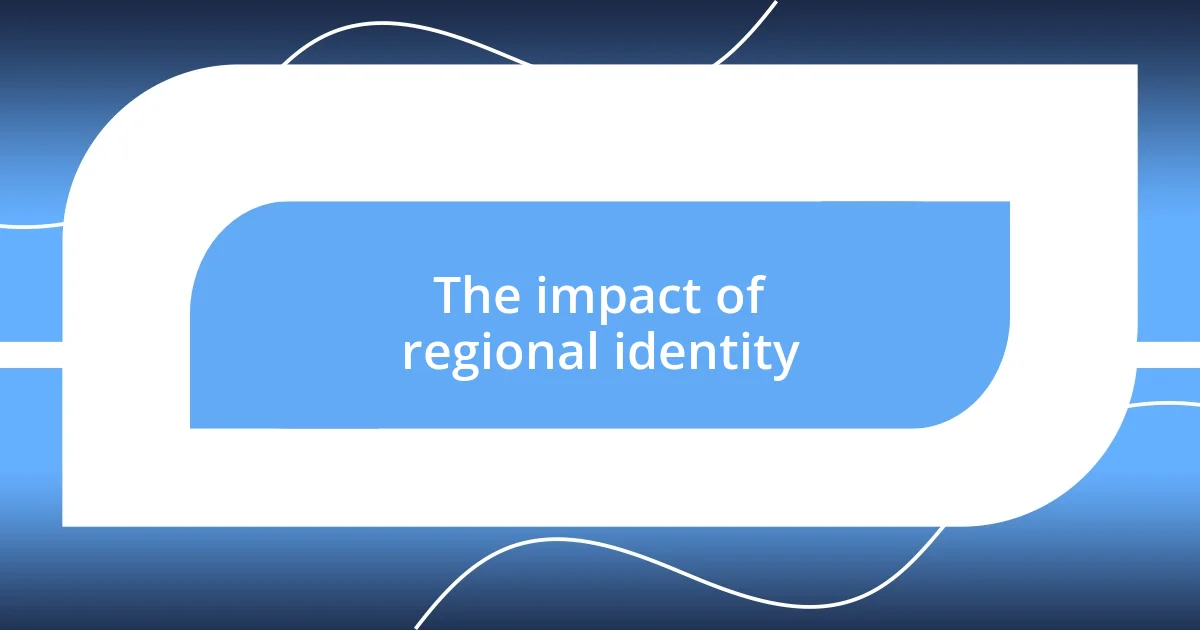Key takeaways:
- Welsh identity is deeply rooted in language, culture, and heritage, evolving while honoring traditional and contemporary influences.
- Significant historical events, such as the rise of the Welsh language and the establishment of the National Assembly, have shaped cultural pride and self-determination in Wales.
- Regional identity fosters community connections through shared traditions and language but can also create barriers, highlighting the need for unity in diversity.

Understanding Welsh identity today
Welsh identity today is a vibrant tapestry woven from threads of language, culture, and heritage. I remember attending a local Eisteddfod, a traditional Welsh festival of literature and music, and feeling a rush of pride when the crowd erupted in song, unifying voices echoing in the midst of the beautiful landscape. How often do we find a moment where culture feels so alive and palpable?
Language plays a crucial role in shaping Welsh identity. When I first attempted to learn a few phrases in Welsh, I felt an exhilarating connection to the region’s history and people. It made me wonder, how can something as simple as a language evoke such deep emotions and connections?
Furthermore, Welsh identity is continuously evolving, reflecting a blend of traditional and contemporary influences. I’ve often found myself in discussions with friends about how modernization impacts our cultural roots, which leads me to ask, can we honor our heritage while embracing change? Understanding this duality is an essential part of what it means to be Welsh today.

Historical context of Welsh identity
Understanding the historical context of Welsh identity involves delving into centuries of struggle and resilience. One poignant moment that resonates with me is the rise of the Welsh language in the face of political suppression. I recall listening to elders recount tales of a time when speaking Welsh could lead to punishment in schools. Their stories painted a vivid picture of a cultural fight for survival, highlighting how the revival of the Welsh language in the latter half of the 20th century symbolized a broader movement towards cultural pride and autonomy.
Welsh identity has also been significantly influenced by various historical events. Here are some key moments to consider:
- Roman Invasion (AD 43): The arrival of the Romans marked the beginning of significant cultural change, introducing new governance and economic systems.
- Henry VII’s Reign (1485): The first Tudor king brought Wales into closer alignment with England, yet also instilled a sense of national pride and identity.
- The Industrial Revolution (18th-19th Century): This era shifted the economic landscape and brought an influx of people, mingling cultures and fostering new dynamics within Welsh society.
- Creation of the National Assembly (1999): This milestone in political representation for Wales signified a renewed focus on Welsh identity and local governance, empowering communities to reclaim their narrative.
These moments remind me that the evolution of Welsh identity is not just about language or folklore; it’s also about the ongoing journey towards recognition and self-determination.

The impact of regional identity
Regional identity in Wales has a profound impact on how individuals perceive themselves and interact with others. I once visited a small village where every shopkeeper greeted me in Welsh, despite my limited vocabulary. This small gesture made me feel like a welcomed member of their community, reminding me how important belonging is. Isn’t it fascinating how something as simple as a language can change the atmosphere of an entire place?
The influence of regional identity extends beyond language; it seeps into the traditions and practices unique to each area. I vividly recall participating in a local harvest festival filled with traditional dance and culinary delights unique to the region. The community’s pride was palpable, and I was struck by how these customs foster a shared sense of belonging. Have you ever felt that rush of connection when surrounded by familiar traditions?
Interestingly, regional identity also brings challenges. While it can be a source of pride, it can also create barriers. I’ve noticed how some individuals from different regions find it difficult to connect due to diverging cultural practices and histories. This disparity raises questions about unity in diversity: how do we bridge the gaps while honoring our unique identities?
| Aspect | Impact |
|---|---|
| Language | Facilitates connection and promotes community identity |
| Traditions | Strengthens community ties and enriches cultural experience |
| Challenges | Creates potential barriers between different regional groups |

How identity shapes community
When I reflect on how identity shapes community, I can’t help but recall a wonderful afternoon at a local gathering in Wales. Everyone came together to celebrate St. David’s Day, proudly donning traditional costumes and sharing stories of their heritage. I felt a surge of warmth and belonging, as though I were part of a larger tapestry woven through generations. Have you ever experienced such a moment where identity truly transcends individual differences and creates a shared space?
Communities thrive on the unique flavors of their identities, and witnessing this firsthand has been enlightening. For instance, during a visit to a community center, I was struck by how everyone referred to each other by their first names, regardless of age or status. This informality fostered a sense of equality, breaking down barriers and inviting open dialogue. It made me wonder: what role does familiarity play in shaping the dynamics of a community?
Moreover, I’ve observed that the shared struggles and triumphs of a community, deeply rooted in their identity, create a powerful bond. Take, for example, the enthusiastic discussions during a local history workshop I attended. Participants, young and old, exchanged stories about past challenges their families faced, reinforcing their connection to one another. Isn’t it incredible how these narratives not only preserve history but also forge unbreakable ties within the community? It’s these shared experiences that remind me of the collective resilience that breathes life into identity and community alike.

Personal reflections on Welsh identity
When I think about Welsh identity, my mind often drifts back to a rainy day in Cardiff, where I found myself at a bustling market. Surrounded by vibrant stalls of local crafts and produce, I felt the energy of a culture that celebrates its uniqueness. It struck me how identity isn’t just about where you’re from; it’s about how that backdrop shapes your values and interactions. Have you ever stood in a place and felt an overwhelming sense of connection to its history?
Another moment that stands out to me is when I attended a poetry reading in a quaint bookstore in Penarth. The passion in the room was palpable as speakers recited works in both Welsh and English. Listening to those rich, melodic rhythms made me appreciate how identity can be expressed through art. It made me wonder: how does the act of sharing stories in different languages deepen our understanding of one another?
Lastly, I’ve often reflected on the contrast between urban and rural Welsh identity. I once took a hiking trip through the Brecon Beacons, and the vast landscapes and tranquil villages whispered stories of resilience and heritage. Being there reminded me that identity isn’t monolithic; rather, it’s a mosaic of experiences shaped by geography and community. Have you ever felt how the environment can influence your sense of self? That interplay between landscape and identity fascinates me, revealing another layer of what it means to be Welsh.














